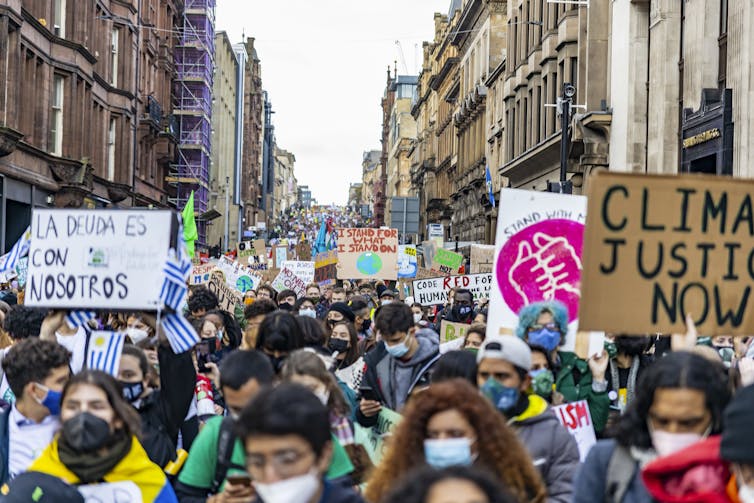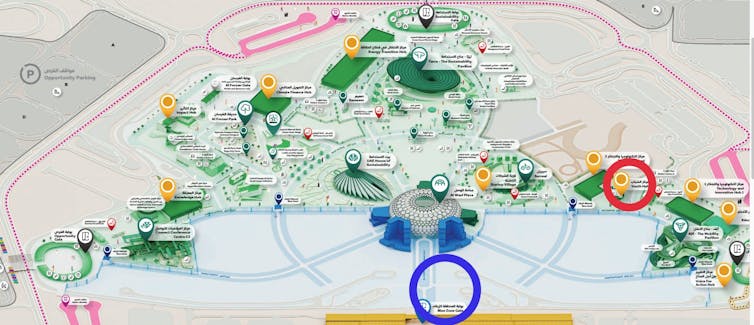Young activists are key figures of the climate movement. So much has been self-evident ever since Greta Thunberg sat outside the steps of the Swedish parliament during school hours in August 2018 and galvanised others from her generation to follow suit in the international movement of Fridays for Future.
But beyond symbolic power, can young people actually sway the outcome of the United Nations’ climate negotiations? A regular attendee of COPs, I decided to research that question after becoming increasingly disillusioned with their inability to create political momentum.
I started this work at a time when media attention for youth-led movements such as Fridays for Future and Youth for Climate was at its peak. But what of it in the two last COPs, COP27 in Sharm el-Sheikh in 2022 and COP28 in Dubai in 2023?
Russian dolls
What makes a COP a success or a failure is debatable.
Some focus on the political pledges that were made at the end of the negotiations, based on what the state parties were able to agree on that year. In Dubai, for example, Member States reached an historic agreement on a loss and damage fund designed to compensate the global south for extreme weather events. For the first time too, the end of fossil fuels was explicitly mentioned in the text. But others were bitterly disappointed, citing the absence of new financial commitments and a number of gaps in the text.
A third group felt that the negotiations represented only a tiny part of the objectives of a COP. In their view, these events play a crucial role in bringing together the climate change community – or at least the part of it privileged enough to make the trip. This annual social occasion is necessary, they feel, to share knowledge, improve practices, raise awareness of emerging issues not yet addressed in the negotiations themselves, and forge links and collaborations across the world.
Distinct players within the same space
The experience of the COPs is thus an eminently individual one. Delegates attending the conference for the first time are often overwhelmed by the number of parallel events taking place in the “blue zone” (which requires accreditation and is officially “UN territory”), not to mention the “green zone” (managed by the host country and open to all).
Over the last two years, I’ve been particularly aware of the scale of these events, as team leader of the Earth Negotiations Bulletin of the International Institute for Sustainable Development (IISD) for the COP side events. Comprising writers, photographers and videographers, the institute’s team provides independent coverage of the COP, ensuring that at least some of what happens on the periphery of the official meetings is shared with a wider audience.
[More than 85,000 readers trust The Conversation newsletters to help them better understand the world’s major issues. Subscribe today]
The way climate COPs are structured highlights a series of distinct actors, but connected in a particular organisational space. But it fails to take into account the power plays and relational dynamics that exist not only between these parties, but also between them and the COP itself. The notion of social fields, described by the French sociologist Pierre Bourdieu, offers a useful lens through which to view these interactions, because it takes into account both the social aspects and the existence of conflicts between players – not just UN and member state delegates, but also energy lobbyists and activists, including young people.
Power struggles and dominant positions
Bourdieu described social fields as:
“a network, or configuration, of objective relations between positions… objectively defined, in their existence and in the determinations they impose on their occupants.”
They’re characterised by power struggles and dominant or dominated positions determined by the parties’ relative accumulation of capital.
My research into young people’s participation in the COPs has led me to formulate hypotheses about two characteristics of these social fields: symbolic power and visibility. I therefore looked at the instrumentalisation of young people at recent COPs and conceptualised their symbolic power as dependent – in particular – on media attention.
In a recent article, I also suggested that young people, partly as a result of media attention during and after the peak of the Fridays for Future protests, had symbolic capital that could be exchanged for political or economic capital.
One might assume that representing themselves as “young” at the UN climate summits, at a time when attention to young people is at its peak, would open doors for them. The reality is more complex.
Young people as instruments?
My research – on which I recently gave a lecture at the University of Geneva – on the experiences of young activists and human rights defenders has revealed that, counter-intuitively, young people are in fact a bargaining chip in global climate policy.
The problem is that any bargaining chip is, by definition, limited, which leads different youth groups to compete for speaking time and visibility. In other words, they are pitted against each other, even though they represent an increasingly wide range of voices since 2019.
More recent observations suggest that there may be an inverse relationship between attention and symbolic power. Indeed, there is a stark contrast between Madrid (COP25) and Glasgow (COP26) – where Fridays for Future, Extinction Rebellion and others had organised protests inside and outside the site – and those in Sharm el-Sheikh (COP27) and Dubai (COP28), where grassroots activism was virtually absent, due to restrictions on demonstrations and, worse still, alleged harassment.

The attention paid to young people and the spaces allocated to them helps us to understand how they intend to define or redefine the “rules of the game” in their social field. Indeed, what was at stake for activists in Paris, Madrid, Glasgow and elsewhere, as well as in the counter-summits usually organised during COPs, was the very limits of the organisation of COPs, where political responsibility, not to mention ambition, is rare.
In Dubai, young people out of sight
COP27 was the first to feature a children and youth pavilion that was not only large – 250 square metres – but also centrally and strategically located in the Blue Zone.
Though this seemed to reflect greater attention, some critics felt that the decision represented an attempt to curb the youth-led climate movement. Indeed, off-site demonstrations had been banned for COP27. Only one type of engagement was possible for young people: through the pavilion events, to the exclusion of any more disruptive action.
In Dubai, it took me longer to find the youth pavilion: this time, it was not in the blue zone, but the green one. In theory, this move was intended to allow greater participation, since the green zone is accessible without an official badge. But, in practice, it also meant that the area dedicated to young people was out of sight of the official delegates, and even further away from the decision-making sites.

Although beautifully decorated, the pavilion seemed adult-run and artificial, with banal quotes about the transformative power of youth posted on the walls, without many young people in sight.
In 2023, I gave a lecture at the French philanthropy agency, Fondation de France, on the transformative power of emotions – anxiety, lucidity, anger – in the face of the climate crisis. All these seemed to be absent from the youth pavilion at COP28.
When Bourdieu doesn’t explain everything
The progressive exclusion of youth-led movements tells us that conceptualising climate conferences as the coming together of a global field of climate advocates remains exploratory rather than definitive.
Indeed, the notion of a field presupposes that all the players agree on what Bourdieu calls the “doxa”, i.e., a foundation of shared opinions and values. It is true that scientific reports such as those by the Intergovernmental Panel on Climate Change (IPCC) play a homogenising role in shaping opinions at climate summits. But the extreme diversity of disagreements and the lack of political shows that it is the very definition of the crisis that remains at stake.
What’s more, this would presuppose that all the participants were climate advocates and committed to resolving the crisis rather than maintaining the status quo. But is this really the case? It is doubtful, given the presence of fossil fuel economies and lobbyists reached record numbers at COP28 in Dubai, according to the 2023 Kick the Big Polluters Out report. As well as because of the difficulties in finding an upstream consensus on how to give meaning and political relevance to climate science, as was visible during the IPCC negotiations on the adoption of the synthesis report of its sixth assessment cycle and its summary for decision-makers.
On the contrary, recent ethnographies have shown how environmental negotiations and treaties help to sustain the conditions of extraction of the global capitalist economy, rather than changing them in any fundamental way.
So the more young activists raise their voices to improve global climate summits, the less welcome they are. This is the story told by the changing symbolic power of young people at the COPs, for the time being at least.


